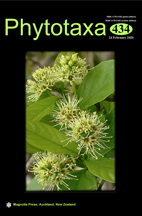Abstract
Combretum eugeneanum, a new species from northeastern KwaZulu-Natal, South Africa and confined to the Maputaland Centre of Plant Endemism, is described, illustrated, mapped, and compared with southern African members of the genus with which it may be confused. In a narrowly defined genus Combretum, the new species belongs to Combretum sect. Ciliatipetala. In herbaria, it has usually been confused with close relatives C. apiculatum and C. edwardsii, as well as several other more distantly related members of the genus, in particular C. woodii. The new species is also closely related to the recently described C. stylesii. It is readily distinguished as an essentially glabrous woody climber or scrambling shrub needing other vegetation for support, leaf apices rarely apiculate, tertiary veins raised on the adaxial leaf surface, inflorescences few-flowered and subcapitate, upper hypanthium cupuliform, flowers with orange-red centres (discs) and peltate scales comprised of essentially eight radial cells, most of which are subdivided by at least one tangential wall, the resulting outer and inner cell(s) often with at least one additional radial wall. Combretum eugeneanum grows in Sand Forest and associated sandy bushveld, and its range and habitat does not overlap with that of C. edwardsii or C. stylesii, both of which are also very often lianas.

